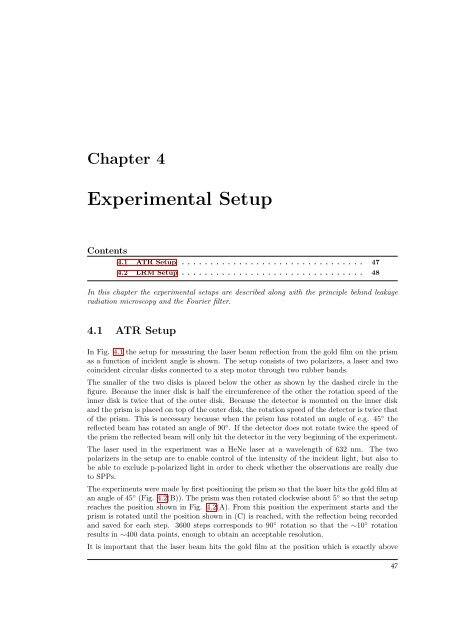P7 – Scattering of Surface Plasmon Polaritons by Gold ... - repetit.dk
P7 – Scattering of Surface Plasmon Polaritons by Gold ... - repetit.dk
P7 – Scattering of Surface Plasmon Polaritons by Gold ... - repetit.dk
Create successful ePaper yourself
Turn your PDF publications into a flip-book with our unique Google optimized e-Paper software.
Chapter 4<br />
Experimental Setup<br />
Contents<br />
4.1 ATR Setup . . . . . . . . . . . . . . . . . . . . . . . . . . . . . . . . 47<br />
4.2 LRM Setup . . . . . . . . . . . . . . . . . . . . . . . . . . . . . . . . 48<br />
In this chapter the experimental setups are described along with the principle behind leakage<br />
radiation microscopy and the Fourier filter.<br />
4.1 ATR Setup<br />
In Fig. 4.1 the setup for measuring the laser beam reflection from the gold film on the prism<br />
as a function <strong>of</strong> incident angle is shown. The setup consists <strong>of</strong> two polarizers, a laser and two<br />
coincident circular disks connected to a step motor through two rubber bands.<br />
The smaller <strong>of</strong> the two disks is placed below the other as shown <strong>by</strong> the dashed circle in the<br />
figure. Because the inner disk is half the circumference <strong>of</strong> the other the rotation speed <strong>of</strong> the<br />
inner disk is twice that <strong>of</strong> the outer disk. Because the detector is mounted on the inner disk<br />
and the prism is placed on top <strong>of</strong> the outer disk, the rotation speed <strong>of</strong> the detector is twice that<br />
<strong>of</strong> the prism. This is necessary because when the prism has rotated an angle <strong>of</strong> e.g. 45 ◦ the<br />
reflected beam has rotated an angle <strong>of</strong> 90 ◦ . If the detector does not rotate twice the speed <strong>of</strong><br />
the prism the reflected beam will only hit the detector in the very beginning <strong>of</strong> the experiment.<br />
The laser used in the experiment was a HeNe laser at a wavelength <strong>of</strong> 632 nm. The two<br />
polarizers in the setup are to enable control <strong>of</strong> the intensity <strong>of</strong> the incident light, but also to<br />
be able to exclude p-polarized light in order to check whether the observations are really due<br />
to SPPs.<br />
The experiments were made <strong>by</strong> first positioning the prism so that the laser hits the gold film at<br />
an angle <strong>of</strong> 45 ◦ (Fig. 4.2(B)). The prism was then rotated clockwise about 5 ◦ so that the setup<br />
reaches the position shown in Fig. 4.2(A). From this position the experiment starts and the<br />
prism is rotated until the position shown in (C) is reached, with the reflection being recorded<br />
and saved for each step. 3600 steps corresponds to 90 ◦ rotation so that the ∼10 ◦ rotation<br />
results in ∼400 data points, enough to obtain an acceptable resolution.<br />
It is important that the laser beam hits the gold film at the position which is exactly above<br />
47


